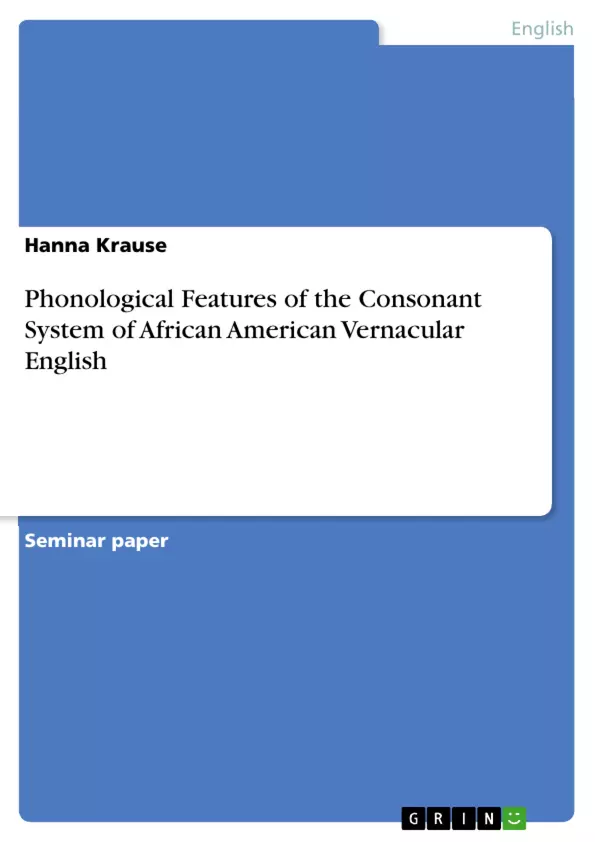This term paper will give a descriptive summary of the sound patterns used in African American vernacular English, but will also go further by discussing the linguistic environments in which such patterns occur. It is restricted to the phonological features of the consonant system of African American vernacular English (AAVE) and does not deal with the characteristics of the vowel system. Furthermore, this term paper should show that speakers of AAVE do not haphazardly insert and delete sound and that it is not fair to evaluate the sounds as “lazy speech” since the patterns used in the sound system of AAVE are completely regular and the way in which sound combinations occur, is very systematic and based on defined rules. This work also tries to make clear what AAVE is and in which ways it is different and similar to general American and Standard English.
The first chapter introduces two different theories about the question how African American English might have been developed. In some contexts, it has been suggested that the pattern of final consonant sounds in AAE has similarities with the pattern of final consonant sounds in West African languages.
Part two deals with the feature of consonant cluster reduction, which has received the most attention in the phonological studies of AAE. Speakers do not always say the same thing the same way all the time, of course, so the percentage rate of reduction may be greater for some speakers than others
Chapter 3 focuses on the fact that interdental fricatives, represented orthographically by th in Standard English, are often realized by labio- dental fricatives among some AAE speakers. It reveals that voicing value of consonant sounds plays a major role in the production of sounds. For example /f/ and /v/ occur in environments in which voiceless th and voiced th occur in Standard English.
Part 4 concentrates on the feature of devoicing and especially on the correlation of the variable /d/ with social class. Data adopted from Wolfram helps to study the speech of Negroes from several socio- economic levels and shows the relationship between the use of sound patterns and extralingusitic factors.
Chapter 5 continues the discussion of consonants, focusing on the liquids /r/ and /l/. It explains environments in which /r/ is not produced by speakers of AAE.
The last chapter lists some other phonological features of AAVE, but not in a detailed way, as there is not enough data available.
Inhaltsverzeichnis (Table of Contents)
- Introduction
- Theories about the development of AAE
- The loss of final consonant sounds
- Realization of /0/ and /o/ as [t,f] and [d,v].
- General Procedure
- Sex and Age
- Devoicing and the correlation of d Variable with Social Class
- General procedure
- Percentage of t and /0/ Realization
- Percentage of t and /Ø/ realization in vocalic and non- vocalic environment.
- Percentage of t and /Ø/ realization when followed by a voiceless consonant, voiced consonant and pause.
- R and 1: liquid vocalization
- General procedure
- Percentage of r Absence
- Environments where unconstructed /r/ can appear
- Additional phonological features
- Conclusion
Zielsetzung und Themenschwerpunkte (Objectives and Key Themes)
This term paper provides a descriptive overview of sound patterns in African American Vernacular English (AAVE), examining the linguistic environments in which these patterns occur. It specifically focuses on the phonological features of AAVE's consonant system, exploring the regularity and systematic nature of its sound combinations. The paper also aims to clarify the distinctive features of AAVE in comparison to General American and Standard English.
- The development and origins of AAE
- The phonological features of AAVE's consonant system
- The systematic nature of sound combinations in AAVE
- The influence of social factors on language variation
- The relationship between AAVE and other varieties of English
Zusammenfassung der Kapitel (Chapter Summaries)
- Introduction: This chapter introduces the purpose of the paper and outlines the key themes to be discussed. It emphasizes the systematic nature of AAVE and its differences from other varieties of English.
- Theories about the development of AAE: This chapter presents two contrasting theories regarding the origins of AAE: the pidgin/creole theory and the dialect theory. It explores the potential influence of West African languages and non-standard English dialects on the development of AAE.
- The loss of final consonant sounds: This chapter focuses on the phenomenon of consonant cluster reduction in AAVE, examining the various explanations for this feature. It discusses the influence of voicing and sonority on the deletion of consonants in specific environments.
- Realization of /0/ and /o/ as [t,f] and [d,v].: This chapter investigates the realization of interdental fricatives in AAVE, exploring the role of voicing and environmental factors. It examines the relationship between the voicing value of consonants and their phonetic realizations.
- Devoicing and the correlation of d Variable with Social Class: This chapter explores the correlation between the variable /d/ and social class in AAE. Using data from Wolfram, it analyzes the relationship between the use of sound patterns and socioeconomic factors.
- R and 1: liquid vocalization: This chapter examines the vocalization of liquids /r/ and /l/ in AAVE. It explores the environments in which /r/ is not produced by speakers of AAVE, revealing the systematic nature of this phonological feature.
Schlüsselwörter (Keywords)
Key terms and concepts explored in this work include: African American Vernacular English (AAVE), phonological features, consonant system, consonant cluster reduction, voicing generalization, sonority analysis, interdental fricatives, labio-dental fricatives, devoicing, social class variation, liquid vocalization, pidgin, creole, dialect, Standard English, General American.
- Quote paper
- Hanna Krause (Author), 2011, Phonological Features of the Consonant System of African American Vernacular English, Munich, GRIN Verlag, https://www.grin.com/document/300341



